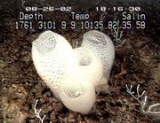
Venus' Flower Basket
Encyclopedia
The Venus' Flower Basket, or Euplectella aspergillum is a hexactinellid sponge in the phylum Porifera inhabiting the deep ocean. In traditional Asia
n cultures, this particular sponge (in a dead, dry state) was given as a wedding gift because the sponge symbiotically
houses two small shrimp, a male and a female, who live out their lives inside the sponge. They breed, and when their offspring are tiny, the offspring escape to find a Venus Flower Basket of their own. The shrimp inside of the basket clean it, and in return, the basket provides food for the shrimp by trapping it in its fiberglass-like strands, and then releasing it into the body of the sponge for the shrimp. It is also speculated that the bioluminescent
light of bacteria harnessed by the sponge may attract other small organisms which the shrimp eat.
They were also extremely popular in Victorian England, and one could easily fetch five guineas, equivalent to over £500 today.
from seawater and converts it into silica, then forms it into an elaborate skeleton of glass fibers. Other sponges such as the orange puffball sponge can also produce glass biologically. The current manufacturing process for optical fibers requires high temperatures and produces a brittle fiber. A low-temperature process for creating and arranging such fibers, inspired by sponges, could offer more control over the optical properties of the fibers. These nano-structures are also potentially useful for the creation of more efficient, low-cost solar cells.
Asia
Asia is the world's largest and most populous continent, located primarily in the eastern and northern hemispheres. It covers 8.7% of the Earth's total surface area and with approximately 3.879 billion people, it hosts 60% of the world's current human population...
n cultures, this particular sponge (in a dead, dry state) was given as a wedding gift because the sponge symbiotically
Inquiline
In zoology, an inquiline is an animal that lives commensally in the nest, burrow, or dwelling place of an animal of another species. For example, some organisms such as insects may live in the homes of gophers and feed on debris, fungi, roots, etc...
houses two small shrimp, a male and a female, who live out their lives inside the sponge. They breed, and when their offspring are tiny, the offspring escape to find a Venus Flower Basket of their own. The shrimp inside of the basket clean it, and in return, the basket provides food for the shrimp by trapping it in its fiberglass-like strands, and then releasing it into the body of the sponge for the shrimp. It is also speculated that the bioluminescent
Bioluminescence
Bioluminescence is the production and emission of light by a living organism. Its name is a hybrid word, originating from the Greek bios for "living" and the Latin lumen "light". Bioluminescence is a naturally occurring form of chemiluminescence where energy is released by a chemical reaction in...
light of bacteria harnessed by the sponge may attract other small organisms which the shrimp eat.
They were also extremely popular in Victorian England, and one could easily fetch five guineas, equivalent to over £500 today.
Optical fibers and solar cells
The glassy fibers that attach the sponge to the ocean floor, 5-20 cm long and thin as human hair, are of interest to fiber optics researchers. The sponge extracts silicic acidSilicic acid
Silicic acid is a general name for a family of chemical compounds of the element silicon, hydrogen, and oxygen, with the general formula [SiOx4-2x]n...
from seawater and converts it into silica, then forms it into an elaborate skeleton of glass fibers. Other sponges such as the orange puffball sponge can also produce glass biologically. The current manufacturing process for optical fibers requires high temperatures and produces a brittle fiber. A low-temperature process for creating and arranging such fibers, inspired by sponges, could offer more control over the optical properties of the fibers. These nano-structures are also potentially useful for the creation of more efficient, low-cost solar cells.

